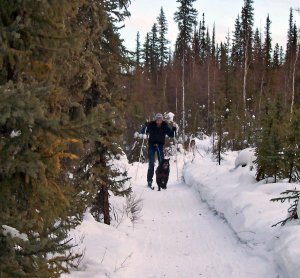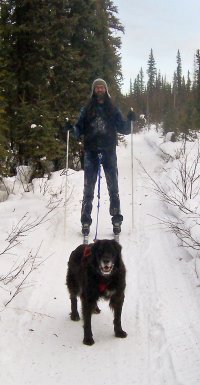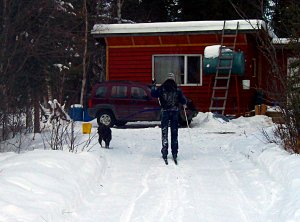When we first moved into our new house I was pleased that the system for keeping the water and waste water lines running in winter was based on circulating warmed glycol, rather than electrical heat tape. Heat tape is known to fail without warning, and sometimes even shorts out and starts a fire.
Unfortunately, the setup is quite peculiar. We’ve got a small heating-oil-fired boiler (the white box on the left of the photo) that heats an internal five gallon water tank. A circulating pump from this tank runs into a plate heat exchanger with the hot water on one side and circulating glycol on the other. A second circulating pump circulates glycol out to the water tank, and back around to the discharge pipe running to the sewage treatment plant. With the boiler set around 165°F, the glycol stays between 80–100°F, depending on the temperature outside. The guy who built the place also ran lines to all the bedrooms and the living room so that hot water or glycol could be used to heat the house, rather than using the small, self-contained Monitor heater we’re using now.
There are a couple problems with this system. In order for the boiler to keep the glycol warm enough via the exchanger, the water temperature has to be quite a bit warmer than is usual for a domestic hot water supply. That’s dangerous for someone not familiar with how hot the water will be when it comes out of the tap, and it’s not all that efficient to keep the hot water at such a high temperature. It also seems like this high temperature is necessary to provide for enough hot water that a normal-length shower will stay warm throughout. And there’s no way the boiler would be up to the task of heating radiators throughout the house, in addition to what it’s doing now.
But the more immediate problem is that the glycol lines were accidentally cut and then improperly repaired before we moved in. We were told that the repair was successful, but when the temperature got cold this winter, glycol started leaking out of the repair. Since the glycol lines are plastic, there’s no way to fix the leak during winter. And even when the lines aren’t leaking at low temperatures, air is slowly drawn into the lines through the same faulty repair. After a couple months, the amount of air in the circulating lines is large enough that the lines become really noisy.
The way to get all the air out of the lines is to recharge the glycol, a procedure I performed for the third time this weekend. This involves connecting a transfer pump to the two sides of the circulating loop with a bucket of glycol in the middle. The procedure is to hook up the transfer pump, turn off the circulating pump, turn on the transfer pump, open the system and allow the transfer pump to circulate glycol for fifteen or twenty minutes until the air has been removed. Then close the return side of the glycol lines and allow a bit of pressure to develop before closing the supply side and turning off the transfer pump. Since the system doesn’t need any pressure at all to operate, the last step before turning on the circulating pump is to carefully open one side of the glycol system and allow most of the pressure in the system to force out the remaining glycol. It’s possible that leaving pressure in the lines might force a bit of glycol out of the leak, rather than allowing air into the system, but I’d rather recharge the lines every couple months than deal with a glycol spill.
This weekend is the Home Show, where a bunch of vendors get together in the Carlson Center and show off their products. I’m hoping we can get some suggestions and ideas from people about a better setup for the house. I have a feeling that a larger boiler, combined with a small hot water storage tank might be a better system. The boiler would be heating water or glycol for the outdoor lines, water for radiators in the house, as well as keeping the hot water storage tank warm for our hot water supply. The space we have available (in the photo) isn’t very large, so we may need to build a small bump out on the back of the house to accommodate the new equipment. Anyway, I’m hoping we can come up with something and maybe even get it installed this summer so we can go through next winter without worrying about what will happen when our small boiler fails (which it did at one point this winter).
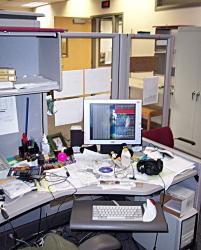
406 cubicle zero, akasofu building, 2002
You may have noticed that this blog (and the rest of my site) has moved to a commercial web hosting provider. After nine years and three months, I’m leaving my job at IARC for a new position at ABR, Inc. ABR is an environmental consulting firm that has been in business in Fairbanks for more than 30 years. They’ve got an excellent reputation in Fairbanks for being a great place to work, and they take their responsibilities toward their employees and the environment very seriously. The new job is much the same as my job at IARC: supporting scientists in their work, and trying to find ways to use technology to help them do their jobs more effectively.
It’s very exciting for me, but at the same time, leaving my office and my co-workers at IARC has been very difficult. After nine years of working with the same group of people, I’ve come to consider many of them my good friends and it is going to be a real struggle to walk out on April 1st. Add to that, this is the first professional job I’ve ever had. I’ve had a lot of jobs (graduate student, teaching assistant, warehouse worker, office director, short-order cook, etc.), but IARC is the place where I learned to be an IT professional, and it’s because of IARC that I was able to get the job at ABR.
Changes: Hard + Good.
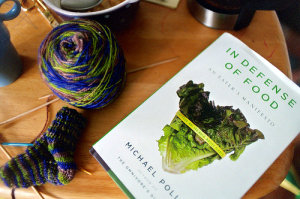
in defense of food. photo by cafemama
Another fantastic book from Michael Pollan. This one is a very quick consideration of what food has become in our society, how it has affected our health, and how we can escape the obvious perils that this diet has caused. The first section considers the rise of “nutritionism,” and if you read his article on the subject from The New York Times Magazine, much of this material will be familiar. The argument is that the discovery of macro- and micro-nutrients has allowed scientists, journalists, and industrial food producers to keep consumers focused on the nutrients in food rather than the food itself. This is important because as food producers began modifying food into food-like substances, they could use the science of nutrition to enrich their food-like substances with what scientists were telling the public they needed. So when you refine whole wheat grains into white flour, you eliminate most of the nutrients from the grains. No problem: just add those nutrients back in. Unfortunately, the evidence suggests that this doesn’t work. Food isn’t just a collection of nutrients, and a loaf of nutrition-enriched bread-like substance made from refined grains, chemical additives and preservatives won’t give you the same benefits of a real loaf of bread made from whole grains, yeast, salt and water.
The second section discusses the “Western Diet,” and how unhealthy it is. He defines the Western Diet as a diet with “lots of processed foods and meat, lots of added fat and sugar, lots of everything except fruits, vegetables, and whole grains” (page 89). As a result of this diet, fortified with all the nutrients and vitamins science tells us we need, two-thirds of Americans are overweight, one-quarter have metabolic syndrome, and the incidence of type 2 diabetes has been going up by 5 percent every year since 1990. The United States is now 45th in the world for life expectancy at birth. The interesting (and hopeful) thing is that the health consequences of this diet can be rapidly reversed by eating differently.
The last section of the book offers some advice on how to modify your own diet in the form of a series of rules. For example, one of the best rules is this one:
Avoid food products containing ingredients that are a) unfamiliar, b) unpronounceable, c) more than five in number, or that include d) high-fructose corn syrup.
This is a tough one to follow. Earlier in the week I went to the supermarket to get hamburger buns, and there were none on the shelf that would be allowed under this rule. All of them had high-fructose corn syrup in them. Short of making my own (which I may try tomorrow), I have no valid choices at the supermarket. All the hamburger buns available don’t really qualify as food.
All the rules are condensed down to one short statement that appears on the cover: “Eat food. Not too much. Mostly plants.” But despite the simplicity of that prescription, reading the book is well worth it. It’s a very quick read, and really brings the point home that we need to think more critically about what we’re eating in this country.
I took Nika out skijoring both days this weekend. She’s still doing really well, although she wasn’t pulling as hard on the way back as she did last weekend. We had a lot of wind on Friday and it blew debris all over the trail, so not only did that slow us down, but there’s a lot more distractions for Nika. Andrea took a few photos as we came back to the house. If you click on the images you can see larger versions. There’s a sled dog team behind me in the first photo.
Andrea is out racing in North Pole and had plenty of handlers, so I decided to stay home. Instead of taking Nika for a regular walk, I waxed my skis and tried skijoring. Andrea taught her to do it almost ten years ago, but Nika hasn’t done it since, and she wasn’t very good at it back then anyway. Today I took her down to the Creek, put on my skis and hooked her up. She knew right away what was going on and she ran straight ahead and pulled like a champion dog. I have a two mile trail that starts on the Creek and then crosses up to the mushing trail in the forest for the return trip home, and Nika was hooked up for about two-thirds of it. On the mushing trail, she was pulling me fast enough that the wind was whistling in my hair and I was worried about what would happen if I fell down (I haven’t been skiing in ten years either…). Luckily, I managed to keep my balance, and except for dipping for poops, she kept up the pace the whole way.
I’m very proud of her. She did a very good job, and both of us had a good time.

